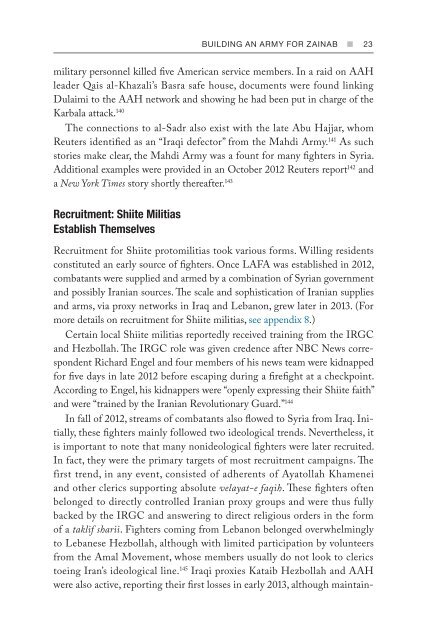You also want an ePaper? Increase the reach of your titles
YUMPU automatically turns print PDFs into web optimized ePapers that Google loves.
BUILD<strong>IN</strong>G AN ARMY FOR ZA<strong>IN</strong>AB n 23<br />
military personnel killed five American service members. In a raid on AAH<br />
leader Qais al-Khazali’s Basra safe house, documents were found linking<br />
Dulaimi to the AAH network and showing he had been put in charge of the<br />
Karbala attack. 140<br />
The connections to al-Sadr also exist with the late Abu Hajjar, whom<br />
Reuters identified as an “Iraqi defector” from the Mahdi Army. 141 As such<br />
stories make clear, the Mahdi Army was a fount for many fighters in Syria.<br />
Additional examples were provided in an October 2012 Reuters report 142 and<br />
a New York Times story shortly thereafter. 143<br />
Recruitment: Shiite Militias<br />
Establish Themselves<br />
Recruitment for Shiite protomilitias took various forms. Willing residents<br />
constituted an early source of fighters. Once LAFA was established in 2012,<br />
combatants were supplied and armed by a combination of Syrian government<br />
and possibly Iranian sources. The scale and sophistication of Iranian supplies<br />
and arms, via proxy networks in Iraq and Lebanon, grew later in 2013. (For<br />
more details on recruitment for Shiite militias, see appendix 8.)<br />
Certain local Shiite militias reportedly received training from the IRGC<br />
and Hezbollah. The IRGC role was given credence after NBC News correspondent<br />
Richard Engel and four members of his news team were kidnapped<br />
for five days in late 2012 before escaping during a firefight at a checkpoint.<br />
According to Engel, his kidnappers were “openly expressing their Shiite faith”<br />
and were “trained by the Iranian Revolutionary Guard.” 144<br />
In fall of 2012, streams of combatants also flowed to Syria from Iraq. Initially,<br />
these fighters mainly followed two ideological trends. Nevertheless, it<br />
is important to note that many nonideological fighters were later recruited.<br />
In fact, they were the primary targets of most recruitment campaigns. The<br />
first trend, in any event, consisted of adherents of Ayatollah Khamenei<br />
and other clerics supporting absolute velayat-e faqih. These fighters often<br />
belonged to directly controlled Iranian proxy groups and were thus fully<br />
backed by the IRGC and answering to direct religious orders in the form<br />
of a taklif sharii. Fighters coming from Lebanon belonged overwhelmingly<br />
to Lebanese Hezbollah, although with limited participation by volunteers<br />
from the Amal Movement, whose members usually do not look to clerics<br />
toeing Iran’s ideological line. 145 Iraqi proxies Kataib Hezbollah and AAH<br />
were also active, reporting their first losses in early 2013, although maintain-


